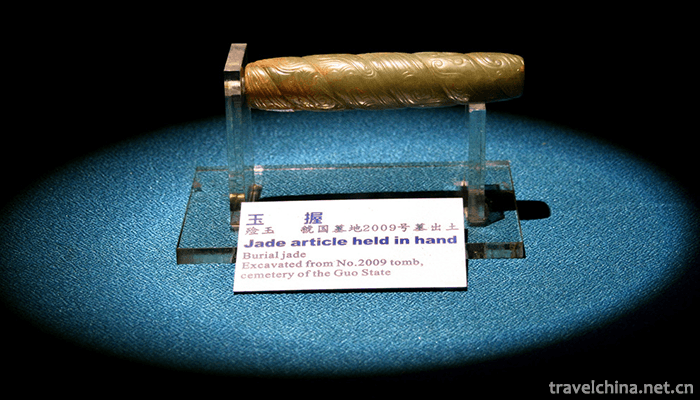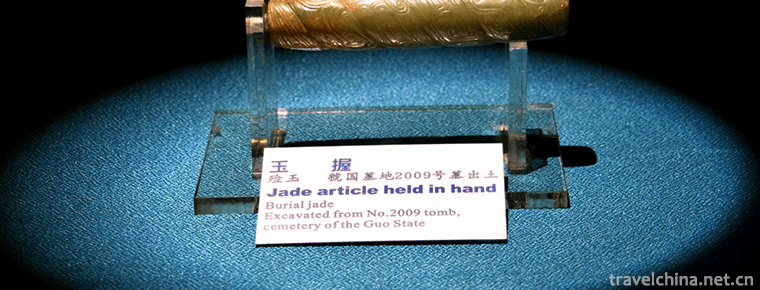Kuanguo Museum
Kuanguo Museum
The Kuanguo Museum is a special museum built on the site of the Kuanguo Cemetery in the Western Zhou Dynasty, a national key cultural relic protection unit. It covers an area of 100,000 square meters. It is a national AAAA-level scenic spot of the second-level museum, which integrates cultural relics display, site display and garden landscape.
There are five basic exhibitions in the Museum of Kuanguo, namely "The Spring and Autumn Period of the Kuanguo State - the Cultural History of the Kuanguo State", "The Essence of Cultural Relics unearthed from Kuangbao Zaiying-the Kuanguo State Cemetery", "The Charm of Liang Ji-the Cultural Relics unearthed from Madame Kuangji's Tomb", "Che Biao-Kuanguo State Che Ma Keng Site" and "The Trace of the King-the Kuangji Tomb Site".
The Kuanguo Cemetery is the only large-scale state cemetery found so far in China in the Western Zhou and Spring and Autumn Periods, with a total area of 324,500 square meters. More than 800 sites have been identified, and nearly 30,000 cultural relics have been unearthed from more than 260 tombs. Especially the tombs of Twin Seasons and Twin Zhongjun excavated in the 1990s. Because of the large number of cultural relics, high value and high level of tomb owner, they were appraised as the top ten new archaeological discoveries in 1990 and 1991, respectively. In April 2001, the site of the Kuanguo Cemetery was rated as "one of the 100 archaeological discoveries of the 20th century in China".
Development history
The Kuanguo Museum is a relic museum built on the foundation of the Kuanguo Tomb. The Kuanguo State was an important feudal state with the surname of Ji in the Western Zhou Dynasty. The founding king was the brother and uncle of King Wen of Zhou Dynasty. In the late Western Zhou Dynasty, it moved eastward to the Sanmenxia area and built Shangyang (now Lijiayao Village, Sanmenxia City, is a provincial cultural relic protection unit). The noble tomb was located in Shangcunling, Sanmenxia City. In 655 B.C., it was destroyed by the Jin Dynasty by the method of "fake killing the cockroaches".
In the 1950s, in order to cooperate with the construction of Sanmenxia Water Conservancy Project, the Chinese Academy of Sciences and the Ministry of Culture jointly formed the "Yellow River Reservoir Archaeological Task Force", led by the famous archaeologists Xia Nang and Anzhimin, to conduct a large-scale archaeological investigation and excavation in the northern Shangcunling of the Sanmenxia Reservoir Area. From then on, the prelude of the excavation and research of the Kuangguo Cemetery was opened.
Since it was discovered in the construction of Sanmenxia Hydro-junction Project on the Yellow River in 1956, it has undergone four drilling and two large-scale excavations. More than 800 sites have been identified, 252 tombs, 7 carriage and horse pits and 3 horse pits have been excavated and cleared, and nearly 30,000 cultural relics have been unearthed.
Beginning in early 1990, the Henan Institute of Cultural Relics and Archaeology conducted a large-scale archaeological investigation and excavation again in the northern Shangcunling Mountains, and found the central area of the Guoguo cemetery, where the emperors of the past dynasties who moved eastward from the West and many high-ranking nobles were buried, as well as their funeral carriage pits, horse pits and sacrificial pits. The second excavation of No. 2001 Kuoji Tomb and No. 2009 Kuozhong Tomb was evaluated as one of the ten new archaeological discoveries in 1990 and 1991, respectively, and one of the "100 archaeological discoveries in the 20th century in China".
In December 1996, the site was promulgated by the State Council as a national key cultural relic protection unit. In order to protect, develop and utilize these precious cultural heritage, Sanmenxia Museum is being built.
In 1998, the main Museum of the Kuanguo Museum started construction. In October 2000, the museum was opened and named "Kuanguo Museum", inscribed by former Director Zhang Wenbin of the State Administration of Cultural Relics.
In 2002, the Kuanguo Museum was designated as a national AAAA-level tourist attraction.
In 2003, the Kuanguo Museum was awarded the Fifth National Top Ten Exhibition Prize.
In 2004, the Kuanguo Museum was awarded the top ten humanistic landscapes in Henan Province.
In 2006, the Kuanguo Museum was awarded "Ten Best Ecological Landscapes in Henan Province" and "Ten Top Scenic Spots in Henan Province".
Honors
In 2002, it was designated as a national 4A-level tourist attraction; in 2003, it was awarded the Fifth National Top Ten Exhibition Quality Award; in 2004, it was awarded the Top Ten Humanistic Landscapes of Henan Province, and won the first, second and third prizes and the Top Ten Announcers of Henan Province in the "Shangdu Cup" Announcers Competition; in 2006, it was awarded the Top Ten Ecological Landscapes of Henan Province and the Top Ten Ten Scenic Spots of Hen
Practical information
- Venue services
Explanation services: Putonghua and English explanations;
Parking service: The parking lot is located in front of the main entrance of the museum, which is convenient for parking.
Shopping Service: All kinds of tourist souvenirs mainly consist of imitations of cultural relics unearthed from Kuangguo Cemetery.
Visit preferential policies
Minors'groups (this city), active servicemen, disabled soldiers, retirees, journalists and tour guides are exempted from tickets; the elderly, students and Guo (Guo) surnames with senile certificates are half-price concessions.
Opening time
Summer and spring (April 1-October 30): 9:00-18:30 (17:30 stop selling tickets);
Autumn and winter (November 1-March 30): 9:00-17:30 (17:00 stop selling tickets)
- Peripheral attractions
Baotayuan (3A) Sanmenxia Dam, Hangguguan (3A), Ganshan Forest Park, Western Henan Grand Canyon, Huashan (4A), Yunchengguan Temple, Yongle Palace, Pujiu Temple (4A), Dead Sea of China.
Traffic information
Train: Sanmenxia Station on Longhai Line or Sanmenxia West get off and enter the urban area;
Self-driving: Lianhuo Expressway enters the urban area from the entrance of Sanmenxia, and Dayun Expressway enters the urban area through the Yellow River Bridge of Sanmenxia.
Bus routes: Sanmenxia Railway Station by No. 1, Sanmenxia Entrance by No. 6, Sanmenxia West Railway Station by No. 5, Shaanxi Road by No. 1.



-
1.Narati Scenic Spot
Narati Tourist Scenic Area, located in Xinyuan County, Xinjiang, is located in the hinterland of Tianshan Mountains, the eastern end of the Ili Valley
Time 2018-12-12 -
2.Three Mausoleum of Shengjing
The three mausoleums outside Guanzhou refer to the Fuling Tombs of Nuerhachi, the Taizong Emperor of the Qing Dynasty, and the Zhaoling Tombs of the Taizong
Time 2019-02-08 -
3.Haimen mountain song
Haimen Mountain Opera is a traditional opera popular in Haimen area of Nantong, Jiangsu Province. It originated from Haimen Mountain Song and developed into
Time 2019-05-02 -
4.Random Bomb Luan tan
Random Bomb, a traditional drama in Taizhou and Pujiang counties of Zhejiang Province, is one of the national intangible cultural heritage.
Time 2019-05-15 -
5.Nanxian Flower Drum
On May 20, 2006, the local flower drum of Nanxian County was listed in the first batch of national intangible cultural heritage list with the approval of the State Council.
Time 2019-06-07 -
6.Sama Dance
Sama dance is a kind of folk dance that the Uygur working people dance together during the New Year's Festival. Its movements are simple and powerful. It is mainly popular in Kashgar and Shache of Sou
Time 2019-06-12 -
7.Stone Appreciation Art
In the form of both pictures and texts, Stone Appreciation Art popularizes the knowledge of Stone Appreciation Art to readers, especially young readers.
Time 2019-06-13 -
8.Shaoxing Pinghu Tune
Shaoxing Pinghu Diao, also known as "Yuejun Nanci", or "Shaoxing Pinghu Diao" for short, is a popular form of folk art in Shaoxing and its surrounding areas in Zhejiang Province. I
Time 2019-06-14 -
9.Legend of Su Xian
The legend of Suxian is a local folklore with a long history. Su Xian, Ming Lian, from Guiyang. Su Da lost his father in his early years and depended on his mother for his life. One year, the plague w
Time 2019-06-17 -
10.Linking Luhe boxing
Xinyi Liuhe Quan, also known as Xinyi Quan and Liuhe Quan, is one of the most famous excellent types of boxing in China, which combines fighting, fitness, self-defense and health preservation. It is o
Time 2019-07-06 -
11.Health preservation in traditional Chinese medicine
Health preservation in traditional Chinese medicine refers to a kind of medical activity that can prolong life by taking care of life, strengthening physique and preventing diseases in various ways. H
Time 2019-08-03 -
12.Daci Temple
Daci Temple, also known as the ancient great saint CI temple, is located in the first section of Dongfeng Road, Jinjiang District, Chengdu City, Sichuan Province. It was built between the 3rd and 4th centuries AD, and is known as "the first jungle of the Sinian".
Time 2020-11-05